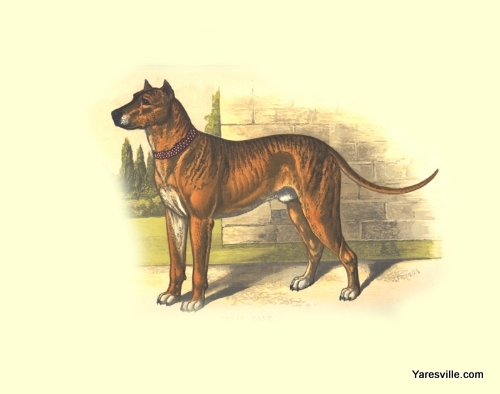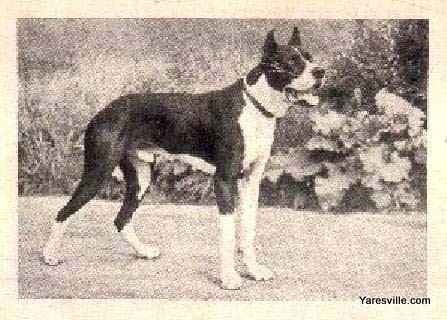Danelike Dogs
 The kynologists generally count breeds with the following characteristics among danelike dogs: strong limb structure, broad forehead, very strongly built muzzle with hanging chops and a tendency to a wrinkled scalp. Nowadays they’re known as Tibetan Dane, Mastiff, Boxer, Bordeaux Dane, Great Dane, Newfundland, St. Bernard Dog, Hovavart and Leonberger.
The kynologists generally count breeds with the following characteristics among danelike dogs: strong limb structure, broad forehead, very strongly built muzzle with hanging chops and a tendency to a wrinkled scalp. Nowadays they’re known as Tibetan Dane, Mastiff, Boxer, Bordeaux Dane, Great Dane, Newfundland, St. Bernard Dog, Hovavart and Leonberger.
Yet, these shapes can also be found among smaller breeds, e.g. British Pug and French Bulldog so that the meaning of danelike does not necessarily refer to the size.
Assyrian hunting and fighting dogs
The oldest illustration of a danelike dog is a relief plaque in a Babylonian temple that has been built in the 12th century b.c. and was renovated by Nebukadnezar in 380 b.c. The plaque shows a colossal danelike dog that is being held on a woven lead by an Assyrian. This Assyrian fighting dog is very similar to today’s Tibetan Dog and despite its short fur identical. Actually the Tibetan Highland seems to have been the source of all danelike dogs.
Again and again the ancient writers mentioned those Indian dogs which were at first kept by Assyrians and Persians and later on by Greeks and Romans. It is to be assumed that when speaking of this Indian dog, they were referring to the Tibetan Dog which were to be found at the foot of the Himalayas in India. Alexander the Great used to bring back danelike dogs as a present from his expedition to India, which founded the famous breed of the Molossians on Greek soil. Later on these dogs have been passed on from Greece to the Roman culture group.
 From the beginning of the calendar Molossian dogs reached the Central and Western European countries via the Alps. It is obvious that the cultural more sophisticated Romans already carried on kynological pure breeding and therefore also bred less heavy, danelike types of dogs for hunting, along with the heavy fighting dogs.
From the beginning of the calendar Molossian dogs reached the Central and Western European countries via the Alps. It is obvious that the cultural more sophisticated Romans already carried on kynological pure breeding and therefore also bred less heavy, danelike types of dogs for hunting, along with the heavy fighting dogs.
Furthermore they imported the praised British dogs that have been brought into action as fighting dogs against the Northern Greek Molossian dogs in Roman arenas.
The selection of these dog-gladiators was made by a so-called “procurator cynogie” – a position specially implemented by the Romans that was situated in Winchester. It is to be assumed that these dogs – by the way, later on they became very famous all over Europe – were the offspring of those dogs imported to England and Ireland by the Celts, where they have been interbreeded with the Irish Wolfhound.
It can be proved by findings of skulls of big dogs that at the same time, danelike dogs also lived in Central Russia, Poland and Central Germany.
We know that the Teutons were accompanied by big, danelike dogs on their campaigns, in order to especially support them in defence of the barricades of wagons.
In the Alemannic Laws of the 7th century a.d. we already come across numerous types of dogs that have been used for hunting. Killing these dogs was a punishable offense.